2014 SUBARU TRIBECA ESP
[x] Cancel search: ESPPage 2 of 426
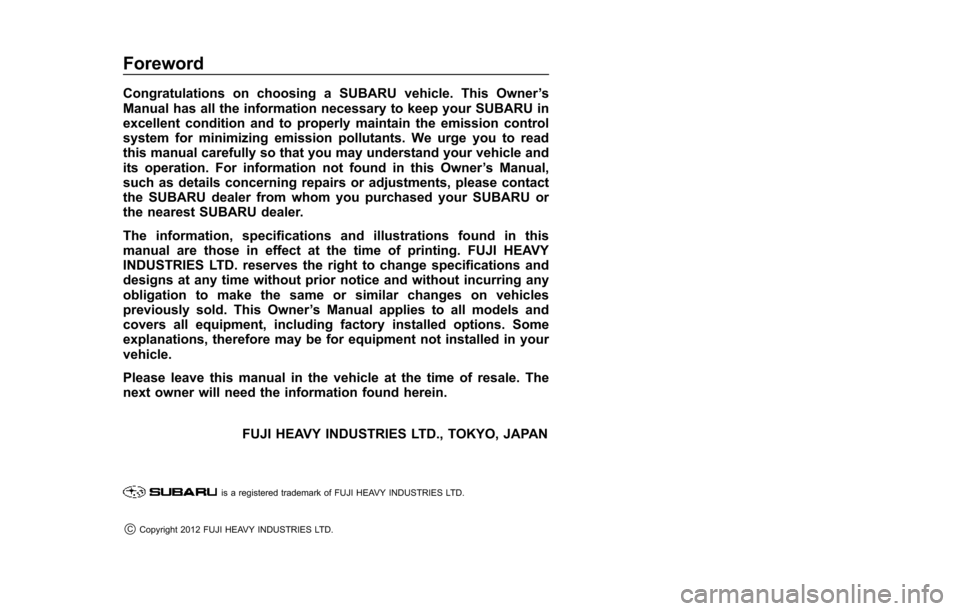
Foreword
Congratulations on choosing a SUBARU vehicle. This Owner’sManual has all the information necessary to keep your SUBARU inexcellent condition and to properly maintain the emission controlsystem for minimizing emission pollutants. We urge you to readthis manual carefully so that you may understand your vehicle andits operation. For information not found in this Owner’s Manual,such as details concerning repairs or adjustments, please contactthe SUBARU dealer from whom you purchased your SUBARU orthe nearest SUBARU dealer.
The information, specifications and illustrations found in thismanual are those in effect at the time of printing. FUJI HEAVYINDUSTRIES LTD. reserves the right to change specifications anddesigns at any time without prior notice and without incurring anyobligation to make the same or similar changes on vehiclespreviously sold. This Owner’s Manual applies to all models andcovers all equipment, including factory installed options. Someexplanations, therefore may be for equipment not installed in yourvehicle.
Please leave this manual in the vehicle at the time of resale. Thenext owner will need the information found herein.
FUJI HEAVY INDUSTRIES LTD., TOKYO, JAPAN
is a registered trademark of FUJI HEAVY INDUSTRIES LTD.
*CCopyright 2012 FUJI HEAVY INDUSTRIES LTD.
Page 11 of 426
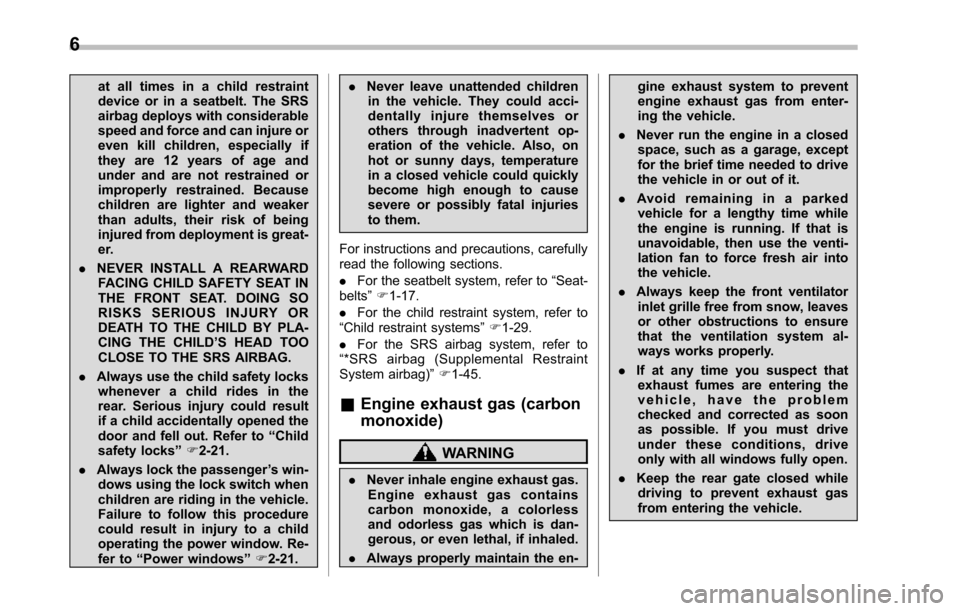
6
at all times in a child restraintdevice or in a seatbelt. The SRSairbag deploys with considerablespeed and force and can injure oreven kill children, especially ifthey are 12 years of age andunder and are not restrained orimproperly restrained. Becausechildren are lighter and weakerthan adults, their risk of beinginjured from deployment is great-er.
.NEVER INSTALL A REARWARDFACING CHILD SAFETY SEAT INTHE FRONT SEAT. DOING SORISKS SERIOUS INJURY ORDEATH TO THE CHILD BY PLA-CING THE CHILD’S HEAD TOOCLOSE TO THE SRS AIRBAG.
.Always use the child safety lockswhenever a child rides in therear. Serious injury could resultif a child accidentally opened thedoor and fell out. Refer to“Childsafety locks”F2-21.
.Always lock the passenger’s win-dows using the lock switch whenchildren are riding in the vehicle.Failure to follow this procedurecould result in injury to a childoperating the power window. Re-fer to“Power windows”F2-21.
.Never leave unattended childrenin the vehicle. They could acci-dentally injure themselves orothers through inadvertent op-eration of the vehicle. Also, onhot or sunny days, temperaturein a closed vehicle could quicklybecome high enough to causesevere or possibly fatal injuriesto them.
For instructions and precautions, carefullyread the following sections.
.For the seatbelt system, refer to“Seat-belts”F1-17.
.For the childrestraint system, refer to“Child restraint systems”F1-29.
.For the SRS airbag system, refer to“*SRS airbag (Supplemental RestraintSystem airbag)”F1-45.
&Engine exhaust gas (carbon
monoxide)
WARNING
.Never inhale engine exhaust gas.Engine exhaust gas containscarbon monoxide, a colorlessand odorless gas which is dan-gerous, or even lethal, if inhaled.
.Always properly maintain the en-
gine exhaust system to preventengine exhaust gas from enter-ing the vehicle.
.Never run the engine in a closedspace, such as a garage, exceptfor the brief time needed to drivethe vehicle in or out of it.
.Avoid remaining in a parkedvehicle for a lengthy time whilethe engine is running. If that isunavoidable, then use the venti-lation fan to force fresh air intothe vehicle.
.Always keep the front ventilatorinlet grille free from snow, leavesor other obstructions to ensurethat the ventilation system al-ways works properly.
.If at any time you suspect thatexhaust fumes are entering thevehicle, have the problemchecked and corrected as soonas possible. If you must driveunder these conditions, driveonly with all windows fully open.
.Keep the rear gate closed whiledriving to prevent exhaust gasfrom entering the vehicle.
Page 33 of 426
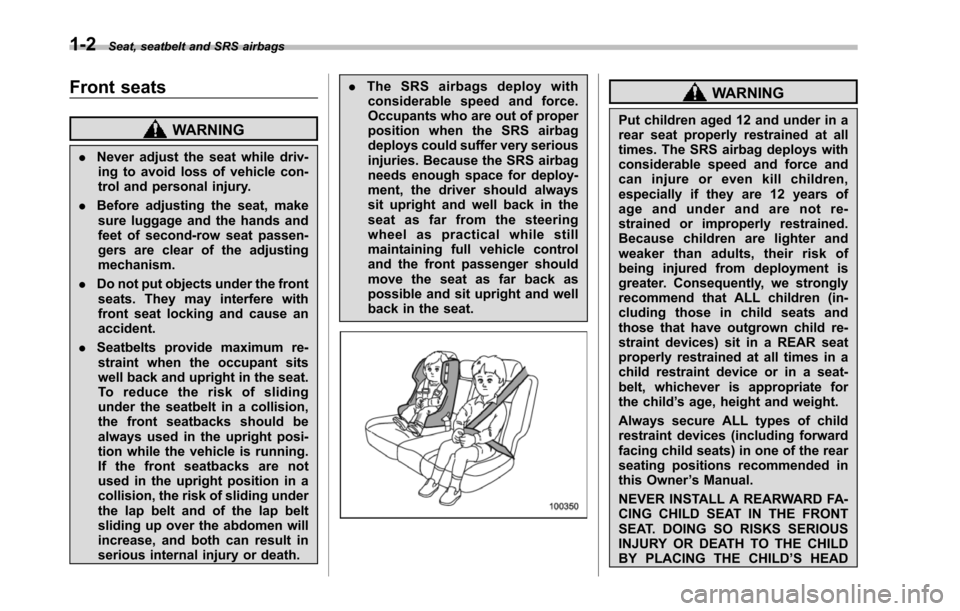
1-2Seat, seatbelt and SRS airbags
Front seats
WARNING
.Never adjust the seat while driv-ing to avoid loss of vehicle con-trol and personal injury.
.Before adjustingthe seat, makesure luggage and the hands andfeet of second-row seat passen-gers are clear of the adjustingmechanism.
.Do not put objects under the frontseats. They may interfere withfront seat locking and cause anaccident.
.Seatbelts provide maximum re-straint when the occupant sitswell back and upright in the seat.To r e d u c e t h e r i s k o f s l i d i n gunder the seatbelt in a collision,the front seatbacks should bealways used in the upright posi-tion while the vehicle is running.If the front seatbacks are notused in the upright position in acollision, the risk of sliding underthe lap belt and of the lap beltsliding up over the abdomen willincrease, and both can result inserious internalinjury or death.
.The SRS airbags deploy withconsiderable speed and force.Occupants who are out of properposition when the SRS airbagdeploys could suffer very seriousinjuries. Because the SRS airbagneeds enough space for deploy-ment, the driver should alwayssit upright and well back in theseat as far from the steeringwheel as practical while stillmaintaining full vehicle controland the frontpassenger shouldmove the seat as far back aspossible and sit upright and wellback in the seat.
WARNING
Put children aged 12 and under in arear seat properly restrained at alltimes. The SRS airbag deploys withconsiderable speed and force andcan injure or even kill children,especially if they are 12 years ofage and under and are not re-strained or improperly restrained.Because children are lighter andweaker than adults, their risk ofbeing injured from deployment isgreater. Consequently, we stronglyrecommend that ALL children (in-cluding those in child seats andthose that have outgrown child re-straint devices) sit in a REAR seatproperly restrained at all times in achild restraint device or in a seat-belt, whichever is appropriate forthe child’s age, height and weight.
Always secure ALL types of childrestraint devices (including forwardfacingchild seats) in one of the rearseating positions recommended inthis Owner’s Manual.
NEVER INSTALL A REARWARD FA-CING CHILD SEAT IN THE FRONTSEAT. DOING SO RISKS SERIOUSINJURY OR DEATH TO THE CHILDBY PLACING THE CHILD’S HEAD
Page 42 of 426
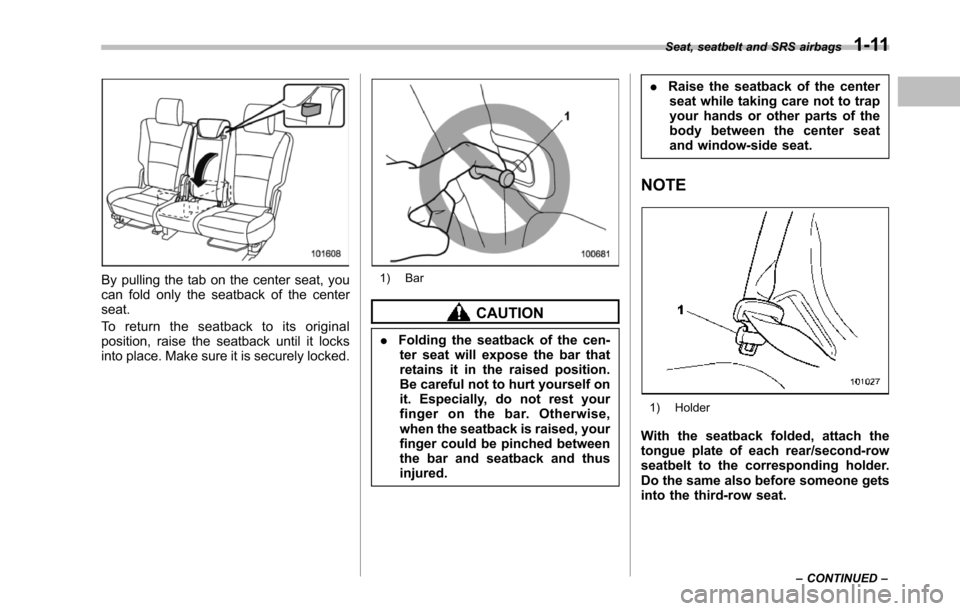
By pulling the tab on the center seat, youcan fold only the seatback of the centerseat.
To r e t u r n t h e s e a t b a c k t o i t s o r i g i n a lposition, raise the seatback until it locksinto place. Make sure it is securely locked.
1) Bar
CAUTION
.Folding the seatback of the cen-ter seat will expose the bar thatretains it in the raised position.Be careful not to hurt yourself onit. Especially, do not rest yourfinger on the bar. Otherwise,when the seatback is raised, yourfinger could be pinched betweenthe bar and seatback and thusinjured.
.Raise the seatback of the centerseat while taking care not to trapyour hands or other parts of thebody between the center seatand window-side seat.
NOTE
1) Holder
With the seatback folded, attach thetongue plate of each rear/second-rowseatbelt to the corresponding holder.Do the same also before someone getsinto thethird-row seat.
Seat, seatbelt and SRS airbags1-11
–CONTINUED–
Page 48 of 426
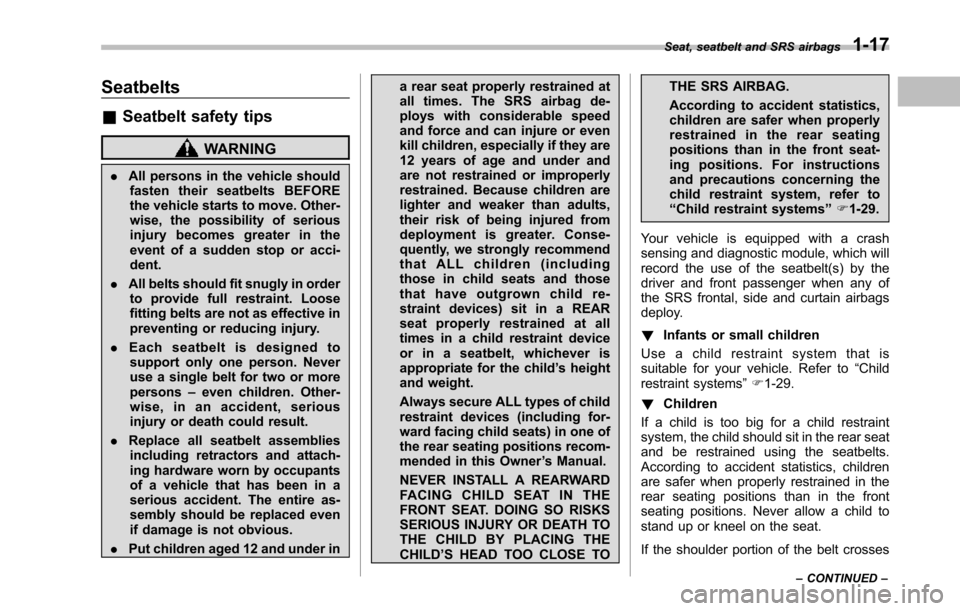
Seatbelts
&Seatbelt safety tips
WARNING
.All persons in the vehicle shouldfasten their seatbelts BEFOREthe vehicle starts to move. Other-wise, the possibility of seriousinjury becomes greater in theevent of a sudden stop or acci-dent.
.All belts should fit snugly in orderto provide full restraint. Loosefitting belts are not as effective inpreventing or reducing injury.
.Each seatbelt is designed tosupport only one person. Neveruse a single belt for two or morepersons–even children.Other-wise, in an accident, seriousinjury or death could result.
.Replace all seatbelt assembliesincluding retractors and attach-ing hardware worn by occupantsof a vehicle that has been in aserious accident. The entire as-sembly should be replaced evenif damage is not obvious.
.Put children aged 12 and under in
a rear seat properly restrained atall times. The SRS airbag de-ploys with considerable speedand force and can injure or evenkill children, especially if they are12 years of age and under andare not restrained or improperlyrestrained. Because children arelighter and weaker than adults,their risk of being injured fromdeployment is greater. Conse-quently, we strongly recommendthat ALL children (includingthose in child seats and thosethat have outgrown child re-straint devices) sit in a REARseat properly restrained at alltimes in a child restraint deviceor in a seatbelt, whichever isappropriate for the child’s heightand weight.
Always secure ALL types of childrestraint devices (including for-ward facing child seats) in one ofthe rear seating positions recom-mended in this Owner’s Manual.
NEVERINSTALL A REARWARDFA C I N G C H I L D S E AT I N T H EFRONT SEAT. DOING SO RISKSSERIOUS INJURY OR DEATH TOTHE CHILD BY PLACING THECHILD’S HEAD TOO CLOSE TO
THE SRS AIRBAG.
According to accident statistics,children are safer when properlyrestrained in the rear seatingpositions than in the front seat-ing positions. For instructionsand precautions concerning thechild restraint system, refer to“Child restraint systems”F1-29.
Your vehicle is equipped with a crashsensing and diagnostic module, which willrecord the use of the seatbelt(s) by thedriver and front passenger when any ofthe SRS frontal, side and curtain airbagsdeploy.
!Infants or small children
Use a child restraint system that issuitable for your vehicle. Refer to“Childrestraint systems”F1-29.
!Children
If a child is too big for a child restraintsystem, the child should sit in the rear seatand be restrained using the seatbelts.According to accident statistics, childrenare safer when properly restrained in therear seating positions than in the frontseating positions.Never allow a child tostand up or kneel on the seat.
If the shoulder portion of the belt crosses
Seat, seatbelt and SRS airbags1-17
–CONTINUED–
Page 53 of 426
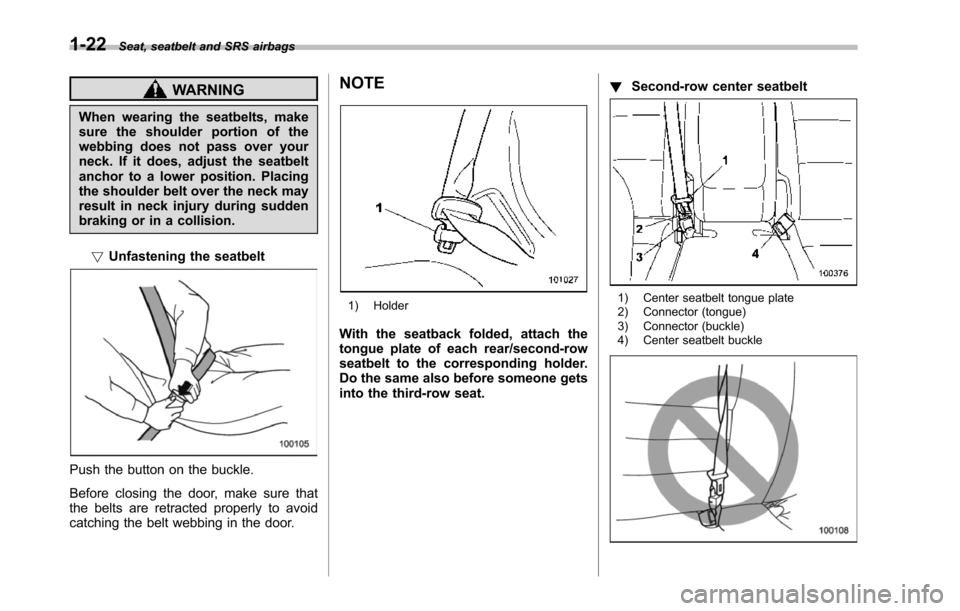
1-22Seat, seatbelt and SRS airbags
WARNING
When wearing the seatbelts, makesure the shoulder portion of thewebbing does not pass over yourneck. If it does, adjust the seatbeltanchor to a lower position. Placingthe shoulder belt over the neck mayresult in neck injury during suddenbrakingor in a collision.
!Unfastening the seatbelt
Push the button on the buckle.
Before closing the door, make sure thatthe belts are retracted properly to avoidcatching the belt webbing in the door.
NOTE
1) Holder
With the seatback folded, attach thetongue plate of each rear/second-rowseatbeltto the corresponding holder.Do the same also before someone getsinto the third-row seat.
!Second-row center seatbelt
1) Center seatbelt tongue plate2) Connector (tongue)3) Connector (buckle)4) Center seatbelt buckle
Page 54 of 426

WARNING
Fastening the seatbelt with the web-bing twisted can increase the risk orseverity of injury in an accident.When fastening the belt after it ispulled out from the retractor, espe-cially when inserting the connec-tor’s tongue plate into the matingbuckle (on right-hand side), alwayscheck that the webbing is nottwisted.
WARNING
Be sure to fasten both tongue platesto the respective buckles. If theseatbelt is used only as a shoulder
belt (with the connector’s tongueplate not fastened to the connec-tor’s buckle on the right-hand side),it cannot properly restrain the wear-er in position in an accident, possi-bly resulting in serious injury ordeath.
Center seatbelt is stowed in the recess ofthe ceiling.
1. Remove the connector (tongue) platefrom the slot located at the front of therecess by pulling the connector (tongue)plate rearward.
2. Pull out the seatbelt slowly from theoverhead retractor.
3. After confirming that the webbing is nottwisted, insert the connector (tongue)attached at the webbing end into thebuckle on the right-hand side until a click
Seat, seatbelt and SRS airbags1-23
–CONTINUED–
Page 62 of 426
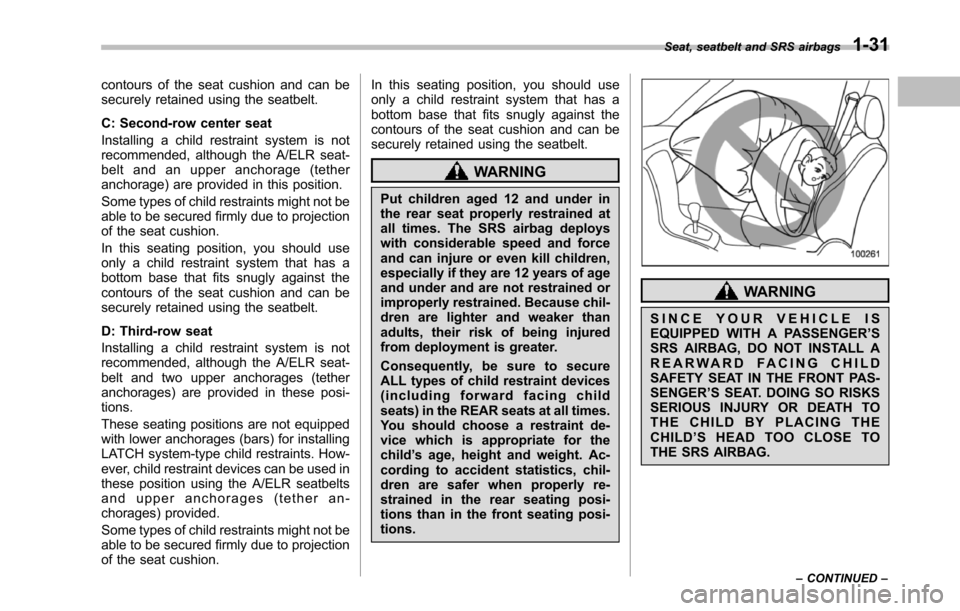
contours of the seat cushion and can besecurely retained using the seatbelt.
C: Second-row center seat
Installing a child restraint system is notrecommended, although the A/ELR seat-belt and an upper anchorage (tetheranchorage) are provided in this position.
Some types of child restraints might not beable to be secured firmly due to projectionof the seat cushion.
In this seating position, you should useonly a child restraint system that has abottom base that fits snugly against thecontours of the seat cushion and can besecurelyretained using the seatbelt.
D: Third-row seat
Installing a child restraint system is notrecommended, although the A/ELR seat-belt and two upper anchorages (tetheranchorages)are provided in these posi-tions.
These seating positions are not equippedwith lower anchorages (bars) for installingLATCH system-type child restraints. How-ever, child restraint devices can be used inthese position using the A/ELR seatbeltsand upper anchorages (tether an-chorages) provided.
Some typesof child restraints might not beable to be secured firmly due to projectionof the seat cushion.
In this seating position, you should useonly a child restraint system that has abottom base that fits snugly against thecontours of the seat cushion and can besecurely retained using the seatbelt.
WARNING
Put children aged 12 and under inthe rear seat properly restrained atalltimes. The SRS airbag deployswith considerable speed and forceand can injure or even kill children,especially if they are 12 years of ageand under and are not restrained orimproperly restrained. Because chil-dren are lighter and weaker thanadults, their risk of being injuredfrom deployment is greater.
Consequently, be sure to secureALL types of child restraint devices(including forward facing childseats) in the REAR seats at all times.You should choose a restraint de-vice which is appropriate for thechild’s age, height and weight. Ac-cording to accident statistics, chil-dren are safer when properly re-strained in the rear seating posi-tions than in the front seating posi-tions.
WARNING
SINCE YOUR VEHICLE ISEQUIPPED WITH A PASSENGER’SSRS AIRBAG, DO NOT INSTALL AREARWARD FACING CHILDSAFETY SEAT IN THE FRONT PAS-SENGER’S SEAT. DOING SO RISKSSERIOUS INJURY OR DEATH TOTHE CHILD BY PLACING THECHILD’SHEADTOOCLOSETOTHE SRS AIRBAG.
Seat, seatbelt and SRS airbags1-31
–CONTINUED–